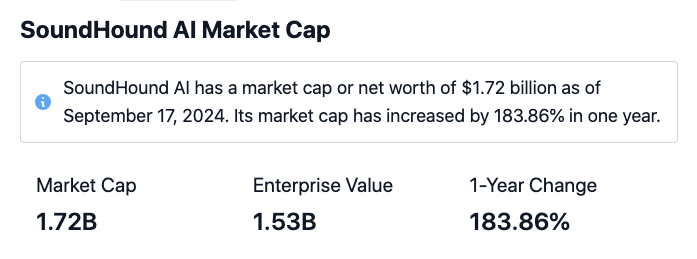20 Pro Ideas For Deciding On Ai Stock Prediction Sites
20 Pro Ideas For Deciding On Ai Stock Prediction Sites
Blog Article
Top 10 Tips For Evaluating The Accuracy And Performance Of Ai Stock Prediction/Analyzing Platforms For Trading
To make sure you're using a system capable of delivering accurate predictions and information It is crucial to test the accuracy and effectiveness of AI platform for predicting stocks and analyzing them. These are the top ten ways to analyze these platforms accurately:
1. Backtesting Results
What to Look for What to Look For: Make sure the platform provides backtesting capabilities to evaluate the way its predictions have performed on historical data.
Why It Matters Backtesting can confirm the AI model's accuracy by comparing its predictions with actual historical outcomes.
Find platforms that provide the possibility of setting up backtesting parameters.
2. Real-Time Performance Tracking
What to Watch Out For What the platform does during real-time conditions.
Why it is Important: The real-time performance of an application is a more accurate indicator than just historical backtesting.
Tip : You can use a demo account or an evaluation version of the software to keep track of the real-time movement and then compare it with your forecasts.
3. Prediction Error Metrics
What to look for Utilize metrics like Mean Absolute Error, Root Mean Squared Error or R-squared to gauge the accuracy of predictions.
Why It's Important: These metrics provide a quantitative measure of how closely predictions are in line with the actual outcomes.
Tip: Platforms that publicly disclose their data tend to be more transparent and trustworthy.
4. The rate of success and winning ratio
What to look out for: Look at the winning rate of the platform that is the percentage of forecasts that are right. Also, check the success ratio (the return on trades using predicted outcomes).
Why It Matters Why it matters: A high winning rate and success ratio indicates better predictive accuracy and potential profitability.
Tips: Be wary of platforms that claim untrue winning rates (e.g. 90%) %+), as no system is perfect.
5. Benchmarking with Market Indices
What to Watch for: Examine the performance and predictions of the platform against the major market indexes.
Why it is crucial because it allows you to determine if the platform is performing better than (or is underperforming) the market overall.
Find out if you can achieve consistent gains over a long duration of time.
6. Congruity in Market Conditions
What to Look For: Assess the performance of the platform in different markets (bull markets and bear markets, as well as high volatility).
What is important: A robust system should perform well not only under favorable market conditions, but in all other conditions too.
Check out the predictions of the platform during volatile markets or market declines.
7. Transparency in Methodology
What to look for How to recognize AI algorithms and models (e.g. reinforcement learning or neural networks).
Transparency of the methodology allows you to assess the scientific rigor and reliability of the platform.
Tip: Avoid platforms that employ "black box" models that do not explain how they generate predictions.
8. Tests and User Reviews
What to look out for: Read reviews from users and verify independent testing.
What is important Reviews and tests conducted by independent experts give unbiased information about the reliability and effectiveness of the system.
Look through forums like Reddit or copyright to see what others have said.
9. Risk-Adjusted Returns
What to look for How to evaluate the platform's performance using risk-adjusted measures such as the Sharpe Ratio or Sortino Ratio.
Why it is Important: This measurement measures the risk taken in order to achieve the desired returns. It offers a more complete view of the performance.
Tip: A Sharpe Ratio (e.g. higher than 1) indicates higher risk-adjusted returns.
10. Long-term Track Record
What to Watch Out For Review the performance of the platform over a longer time (e.g. for 3-5 years).
What is important Why it matters: Long-term performance is an accurate indicator over short-term results.
Tip: Do not use platforms that show only temporary or limited performance.
Bonus Tip: Test with an account that is a demo
You can try out predictions made by the platform in real-time without risking any money, by signing up for a free trial or demo account. You can test the accuracy and efficiency of the system firsthand.
Utilize these suggestions to fully assess the accuracy, efficiency and reliability of AI stock prediction and analysis platforms. You can then choose a platform that best aligns with your trading objectives, and your ability to take risks. Keep in mind that no trading platform is perfect, and the best strategy is to blend AI insights with personal research. Have a look at the best ai for trading recommendations for more examples including ai investment platform, ai stock trading, getstocks ai, investing ai, trader ai app, copyright ai trading bot, stock analysis tool, ai investing app, stock analysis tool, coincheckup and more.
Top 10 Tips For Evaluating The Risk Management Of Ai Stock Forecasting/Analyzing Trading Platforms
A platform for trading that makes use of AI to predict/analyze stocks must have a robust risk management process. This can protect your investment capital and minimize any potential losses. Platforms with robust risk management tools can help you navigate turbulent stock markets and make an decisions based on information. Here are 10 suggestions on how you can evaluate the platform's risk management capabilities.
1. Evaluation of Stop-Loss and Take-Profit Features
Levels that can be customized - Make sure that the platform lets you customize your stop-loss, take-profit and profit level for every strategy or trade.
Trailing stops: Make sure the platform supports trailing stops that automatically adjust when the market changes to your advantage.
If the platform provides stop-loss order guarantees that the position will be closed to the specified price in markets that are volatile and you are assured of a successful trade.
2. Use Position Sizing Tools to Assess Positions
Fixed amount: Ensure the platform permits you to define position sizes based on a fixed monetary amount.
Percentage of your portfolio: See whether you can establish the size of your positions in percentages of your portfolio total to manage risk proportionally.
Risk-reward: Check if your platform permits you to determine risk-rewards for each strategy or trade.
3. Look for Diversification support
Multi-asset Trading to diversify your investment portfolio, ensure that the trading platform you select can handle trading in a variety of asset classes.
Sector allocation: Check whether the platform has tools for monitoring and managing the exposure of sectors.
Geographic diversification: Check if the platform you trade on has international markets available in order to spread geographical risk.
4. Evaluating margin and leverage controls
Margin requirements - Make sure that the platform explains the margin requirements clearly.
Check for limits on leverage. You can utilize this feature to control your risk exposure.
Margin calls: Ensure that you get timely notifications from the platform in order to ensure that your account is not liquidated.
5. Evaluation of Risk Analytics and Reporting
Risk metrics: Ensure whether your platform contains key risk metrics including Value at Risk, Sharpe ratio, as well as Drawdown for your portfolio.
Scenario Analysis: Determine the platform you use allows the ability to simulate various market scenarios to assess possible risks.
Performance reports: Ensure the platform provides you with detailed reports on performance, as well as returns that are risk-adjusted.
6. Check for Real-Time Risk Monitoring
Portfolio monitoring - Ensure that the platform you choose has real-time monitoring in order to ensure your portfolio is protected.
Alerts & notifications: Verify the platform's ability to provide real-time alerts for events that may be risky (e.g. breached margins or Stop losses triggers).
Check for customizable dashboards that give you an overview of your risk profile.
7. Evaluation of Backtesting and Stress Testing
Test your strategies for stress: Ensure that the platform you choose allows you to test your portfolio and strategies under extreme market conditions.
Backtesting. Check whether the platform allows for backtesting, which is the application of historical data to evaluate the level of risk and performance.
Monte Carlo: Verify the platform's use Monte Carlo-based simulations to evaluate the risk and modeling a range or possible outcomes.
8. Evaluation of Compliance Risk Management Regulations
Ensure that the platform meets the regulatory compliance requirements (e.g. MiFID II regulations in Europe, Reg T regulations in the U.S.).
Best execution: Make sure that the platform is in line with best execution practices, ensuring trades are executed at the most competitive possible price, minimizing slippage.
Transparency Examine the transparency of the platform and the clarity of risk disclosure.
9. Look for risk parameters that are user-controlled
Custom risk management rules: Ensure the platform you choose allows you to create customized risk management rules.
Automated risk controls You should check whether your platform is able to apply risk management rules upon the parameters you've defined.
Manual overrides: Make sure that the platform supports manual overrides in emergency situations.
Study Case Studies, User Feedback Review Case Studies, User Feedback Case Studies
User feedback: Use user reviews to evaluate the platform's ability to take care of risk.
Case studies or testimonials should highlight the platform’s capability to handle the risks.
Community forums: Find out if there's an active community of traders that share advice and strategies for risk management.
Bonus Tips
Trial period: Try a free trial or demo to test the features of the platform for risk management in real-world situations.
Customer support - Ensure that your platform provides a solid support for issues and questions concerning risk.
Educational resources: Discover if your platform offers educational materials or tutorials which explain risk management strategies.
Use these guidelines to evaluate the risk management abilities of AI trading platforms that predict/analyze the price of stocks. Select a platform that has an excellent degree of risk management, and you can minimize your losses. To ensure that your trading is successful and manage volatile markets, strong risk management tools are vital. Check out the recommended incite for website info including ai stock price prediction, ai copyright trading bot, copyright financial advisor, trader ai review, free ai trading bot, coincheckup, ai trading platform, canadian ai stocks, ai based trading platform, trader ai review and more.